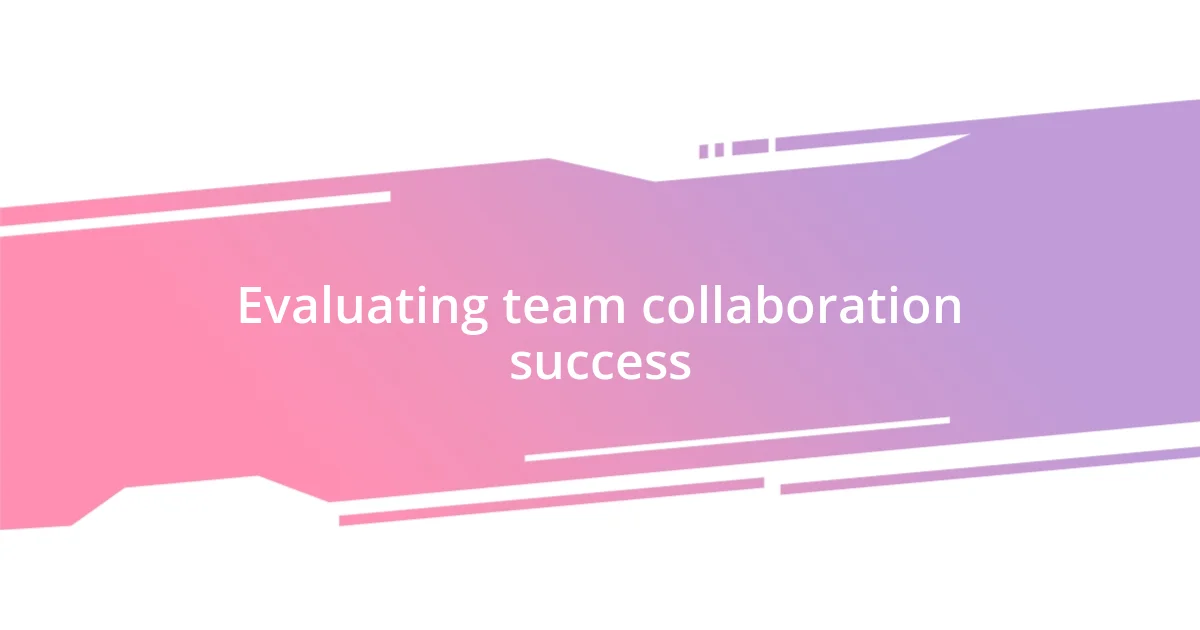Key takeaways:
- Effective team collaboration hinges on clear communication, trust, and a shared vision, fostering an environment ripe for innovation and connection.
- Identifying personal collaboration styles, including communication preferences and conflict resolution, enhances team dynamics and inclusivity.
- Building trust within a team is facilitated through vulnerability, consistency in actions, and celebrating successes, which strengthens relationships and fosters a supportive atmosphere.

Understanding team collaboration principles
Team collaboration principles are fundamentally built on clear communication. In my experience, when team members feel comfortable sharing their thoughts and feedback, it fosters an environment where ideas can flourish. Have you ever been in a meeting where everyone nods in agreement, but no one really speaks up? That silence can often lead to missed opportunities for innovation.
Another critical principle is trust. I remember a project where my team struggled initially because we all had different working styles. When we took the time to understand each other’s strengths and openly discussed our challenges, we built a level of trust that transformed our dynamic. It felt liberating to realize that vulnerability can actually lead to greater collaboration. What does trust look like in your teams?
Finally, I’ve learned that a shared vision can serve as a guiding star for collaboration. When everyone is aligned on the goal, it creates a sense of purpose that drives collective effort. I once worked on a team that transformed a daunting project into an exciting challenge simply by connecting our individual tasks to a bigger picture. How does your team create that shared vision? As I reflect on this, I see how integral these principles are in shaping not just successful teams, but also the overall work experience.

Identifying personal collaboration style
Understanding your personal collaboration style is key to engaging effectively with your team. I’ve discovered that my collaboration style leans toward being a mediator, helping others express their ideas and resolving conflicts. In one project, I noticed that a quiet team member had brilliant insights but often held back. I made it a point to include them in discussions, and it was amazing to see their contributions spark new ideas and excitement among us all. Recognizing how I fit in the collaboration puzzle not only boosts my confidence but also allows me to create a more inclusive environment for everyone.
To help identify your personal collaboration style, consider these aspects:
- Communication Preferences: Do you prefer direct communication or a more nuanced approach?
- Conflict Resolution: How do you handle disagreements? Do you avoid them, or do you confront them head-on?
- Role Comfort: Are you more comfortable leading discussions, or do you thrive in supportive roles?
- Feedback Reception: How do you react to constructive criticism? Do you see it as an opportunity for growth or as a personal attack?
- Engagement Level: Do you actively participate in team activities, or do you prefer to observe and engage selectively?
Reflecting on these points can provide valuable insights into how you collaborate with others and what adjustments you might make to enhance team dynamics.

Tools for effective teamwork
When it comes to tools for effective teamwork, I’ve found that selecting the right platforms can make all the difference. For instance, my team swears by project management software like Asana. It’s incredibly user-friendly and allows us to assign tasks, set deadlines, and track progress seamlessly. I remember a time when we were juggling multiple projects, and Asana kept us organized, ensuring no deadline slipped through the cracks. What tools do you find indispensable for managing your team’s workload?
Another valuable tool we leverage is Slack for communication. I cherish how it brings our conversations to life through instant messaging and channels dedicated to specific topics. In a recent project, we had a brainstorming session where ideas flowed instantly, and it felt exhilarating to connect with my teammates in real-time—no more waiting for responses! Have you experienced the power of immediate communication in your workflow?
| Tool | Functionality |
|---|---|
| Asana | Project management, task assignment, and deadline tracking |
| Slack | Instant messaging, real-time communication, topic-specific channels |
| Trello | Visual project organization using boards and cards |
| Zoom | Video conferencing for remote meetings and collaboration |

Techniques for active listening
Active listening is a vital technique I cherish in team collaboration. One method that really resonates with me is the “think-pair-share” approach. During a challenging project, I proposed this technique in a team meeting, allowing everyone to gather their thoughts individually before engaging in pairs. The result was astounding—everyone felt more empowered to share their ideas, and I could see the spark of creativity ignite as we collectively brainstormed solutions.
I also find that using body language is crucial for active listening. When I’m really invested in a conversation, I consciously nod and maintain eye contact. There was a moment in a meeting where a colleague expressed vulnerability about their project struggles. My attentiveness through body language made them feel valued, which encouraged them to open up further. Have you ever noticed how a simple gesture can transform the dynamics of a conversation?
Finally, summarizing what I’ve heard is a game changer. After a discussion, I often paraphrase key points back to the speaker. I remember a time when a teammate felt misunderstood in a project review. By restating their concerns, I not only clarified my understanding but also reassured them that their voice was heard. This technique fosters trust and strengthens relationships, making collaboration much smoother. What’s your experience with ensuring your teammates feel listened to?

Strategies for clear communication
One strategy that has always resonated with me for clear communication is setting ground rules at the onset of a project. I recall a time when my team kicked off a complex initiative, and we agreed that no question was too trivial to ask. Establishing this norm not only encouraged openness but also fostered a sense of safety among the team members. Have you ever felt hesitant to speak up, wondering if your question was too basic? With our ground rule in place, I was pleasantly surprised by how many critical insights emerged just from this simple practice.
Another effective approach I’ve employed is utilizing visual aids during discussions. I vividly remember a project where I created a flowchart to outline our workflow. Presenting it in our first meeting transformed a challenging concept into a digestible format. The moment my teammates started to connect the dots and see the bigger picture, their enthusiasm grew—making it easier for everyone to grasp their roles clearly. Don’t you think visuals can often bridge gaps that words alone can’t?
Lastly, being mindful of tone and word choice can dramatically influence interaction quality. Early in my career, I didn’t realize how a misplaced tone could derail a conversation. During a tense discussion about deadlines, I learned the hard way that my well-meant urgency felt like pressure to some team members. Ever since, I’ve made a conscious effort to soften my delivery, ensuring that my intentions are clear and supportive. This subtle shift has not only improved clarity but has also strengthened our team bond. What shifts have you made in your communication style to enhance collaboration?

Building trust within the team
Building trust within a team hinges on vulnerability. I recall a team retreat where, during an icebreaker, we were asked to share personal challenges. As I opened up about my struggles with balancing work-life commitments, I noticed an immediate shift. Others followed suit, revealing their own vulnerabilities. That moment forged deeper connections among us. Have you ever felt how sharing a personal story can break down barriers and create a safe space for honest dialogue?
Another essential aspect of building trust is consistency in our actions and commitments. Early in my career, I missed a deadline on a vital project, and it felt like I had let my team down. From that point, I made it a point to communicate proactively about my workload and set realistic expectations. By consistently following through on my commitments, I’ve fostered an environment where my teammates feel secure in their reliance on me. How do you think consistency contributes to a trusting atmosphere?
Lastly, I find that celebrating each other’s successes significantly boosts trust within the team. I vividly remember a project where one of my colleagues delivered an outstanding presentation. Instead of just acknowledging it in a formal review, I took the time to highlight their achievement during a team lunch. The look of appreciation on their face was heartwarming, and it encouraged others to share their victories, big or small. Don’t you think recognition can create a powerful bond that strengthens teamwork?

Evaluating team collaboration success
Evaluating the success of team collaboration often requires looking beyond mere productivity metrics. I remember a project where we not only assessed the final outcome but also gathered feedback throughout the process. This continuous evaluation revealed not just how well we worked together but also highlighted areas for improvement—after all, wouldn’t you agree that growth stems from recognizing our weaknesses?
Another critical aspect of evaluation lies in observing team dynamics during meetings. One time, I facilitated a retrospective session where team members shared their experiences openly. The candid discussions brought to light unspoken tensions and areas of misalignment. Seeing people connect their feelings to our workflow was eye-opening; it was clear that communication and connection were just as vital to our success as the tasks we completed.
Lastly, leveraging tools like anonymous surveys can provide valuable insights into team collaboration. I once implemented a simple poll after a project’s completion, asking everyone to rate their experience and share suggestions. The candid feedback was overwhelmingly positive yet pointed out subtle friction points I hadn’t noticed. This approach not only validated our efforts but also equipped us with specific actions to enhance our future teamwork. Don’t you think that listening to all voices can often lead to deeper understanding and improvement?














